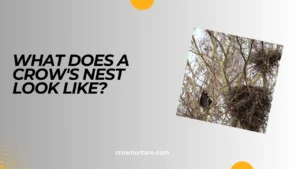Crows are among the most intelligent birds on the planet, capable of solving complex problems and using tools. Yet, despite their remarkable abilities, one of their most impressive feats is often overlooked: the creation of their nests.
Crows build intricate, strong structures to raise their young, showcasing not only their intelligence but also their understanding of safety, comfort, and the environment.
Nest building isn’t just about constructing a place to lay eggs—it’s a process full of creativity and strategic thinking. As we delve into the world of crow nests, we’ll discover how these birds select materials, build their homes, and choose the perfect location.
From their meticulous craftsmanship to the challenges they face, crow nests offer a unique insight into the lives of these fascinating creatures. In this article, we’ll explore the characteristics of crow nests, the building process, and the importance of nest placement.
We’ll also discuss the challenges that nesting crows face, from predators to environmental hazards. Understanding crow nests is more than just an interesting fact—it’s crucial to our understanding of their behavior, survival, and role in ecosystems.

Contents
1. Characteristics of Crow Nests
- Size and Shape:
Crow nests are large and often untidy, typically measuring up to 3 feet in diameter. Their bulkiness is necessary for sheltering young chicks and supporting multiple layers. - Nest Materials:
Crows use a wide range of materials such as twigs, branches, mud, grass, feathers, and even human-made objects like fabric or string to build their nests. - Nest Structure:
A typical crow nest consists of a sturdy outer layer of sticks, an inner layer of finer twigs, and a soft, insulating lining made of feathers and other soft materials.
2. The Nest-Building Process
- Pair Bonding:
Both male and female crows are involved in the nest construction process, with a strong bond between the pair. This cooperative effort strengthens their relationship and ensures a better quality nest. - Nest Site Selection:
When choosing a location, crows consider tree height, proximity to food, and protection from predators. Higher, more secluded areas are often preferred for safety. - Nest Construction:
The process starts with the gathering of materials, followed by building the foundation. The final touches include lining the nest with softer materials for comfort and warmth.

3. Importance of Nest Placement
- Safety and Security:
A secure nesting location is crucial to protect eggs and chicks from predators like hawks, owls, and raccoons. Crows typically build their nests in tall, dense trees to maximize security. - Environmental Factors:
Factors such as wind, rain, and temperature influence where crows build their nests. They often select sheltered spots to protect the nest from harsh weather conditions. - Territoriality:
Crows are territorial and defend their nest sites from other birds, ensuring their young are not at risk of predation or competition.
4. Challenges Faced by Nesting Crows
- Predation:
Crows face numerous threats, including predation by hawks, raccoons, and even larger birds like eagles. Protecting the nest is a major challenge. - Habitat Loss:
As urbanization increases, natural nesting sites are lost, forcing crows to adapt to cities where space and shelter are more limited. - Environmental Pollution:
Pollution affects the health of the birds and the quality of materials used in building their nests. Exposure to toxic substances can harm the crow population and its nesting success.
5. The Role of Crow Nests in Ecosystems
- Ecological Importance:
Crow nests play a vital role in the ecosystem, helping with seed dispersal and controlling pest populations. These nests contribute to the balance of nature. - Social Bonds:
Building a nest is not just a physical task but also a social one, with crows forming strong pair bonds that last throughout their lives. - Conservation:
Understanding crow nests and their challenges is crucial for conservation efforts aimed at preserving both the species and their habitats.
Conclusion
Crows are skilled nest builders, creating intricate structures that ensure the survival of their young. Their nest-building process reflects their intelligence, social cooperation, and adaptability to their environment.
Crow nests are more than just homes; they are key to understanding the species’ survival and role in ecosystems. Protecting these nests and their habitats is crucial for maintaining healthy crow populations and the broader ecological balance.
As we continue to learn more about these fascinating birds, it’s clear that their nesting behaviors are a testament to their intelligence and resilience. The next time you see a crow flying overhead, remember the complex and impressive nest they’ve built—it’s a true marvel of nature.
FAQs
1. Do crows make nests?
Yes, crows build nests, typically in tall trees or urban areas, using twigs, feathers, and other materials.
2. How big are crow nests?
Crow nests can be up to 3 feet in diameter, often appearing large and somewhat untidy.
3. What materials do crows use to build their nests?
Crows use twigs, branches, mud, grass, feathers, and even human-made items like string and fabric.
4. How long does it take crows to build a nest?
It typically takes several days to a few weeks for crows to build their nests, depending on material availability.
5. Where do crows build their nests?
Crows often build their nests in tall trees or in urban areas with easy access to food and shelter.
6. How do crows protect their nests from predators?
Crows often build their nests in secluded areas and are highly territorial, defending their nests from predators.








